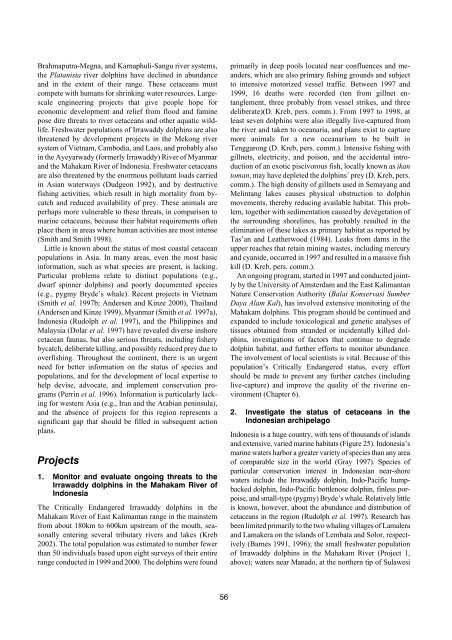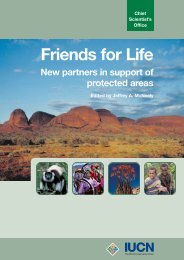Dolphins, Whales and Porpoises: 2002-2010 Conservation - IUCN
Dolphins, Whales and Porpoises: 2002-2010 Conservation - IUCN
Dolphins, Whales and Porpoises: 2002-2010 Conservation - IUCN
You also want an ePaper? Increase the reach of your titles
YUMPU automatically turns print PDFs into web optimized ePapers that Google loves.
Brahmaputra-Megna, <strong>and</strong> Karnaphuli-Sangu river systems,<br />
the Platanista river dolphins have declined in abundance<br />
<strong>and</strong> in the extent of their range. These cetaceans must<br />
compete with humans for shrinking water resources. Largescale<br />
engineering projects that give people hope for<br />
economic development <strong>and</strong> relief from flood <strong>and</strong> famine<br />
pose dire threats to river cetaceans <strong>and</strong> other aquatic wildlife.<br />
Freshwater populations of Irrawaddy dolphins are also<br />
threatened by development projects in the Mekong river<br />
system of Vietnam, Cambodia, <strong>and</strong> Laos, <strong>and</strong> probably also<br />
in the Ayeyarwady (formerly Irrawaddy) River of Myanmar<br />
<strong>and</strong> the Mahakam River of Indonesia. Freshwater cetaceans<br />
are also threatened by the enormous pollutant loads carried<br />
in Asian waterways (Dudgeon 1992), <strong>and</strong> by destructive<br />
fishing activities, which result in high mortality from bycatch<br />
<strong>and</strong> reduced availability of prey. These animals are<br />
perhaps more vulnerable to these threats, in comparison to<br />
marine cetaceans, because their habitat requirements often<br />
place them in areas where human activities are most intense<br />
(Smith <strong>and</strong> Smith 1998).<br />
Little is known about the status of most coastal cetacean<br />
populations in Asia. In many areas, even the most basic<br />
information, such as what species are present, is lacking.<br />
Particular problems relate to distinct populations (e.g.,<br />
dwarf spinner dolphins) <strong>and</strong> poorly documented species<br />
(e.g., pygmy Bryde’s whale). Recent projects in Vietnam<br />
(Smith et al. 1997b; Andersen <strong>and</strong> Kinze 2000), Thail<strong>and</strong><br />
(Andersen <strong>and</strong> Kinze 1999), Myanmar (Smith et al. 1997a),<br />
Indonesia (Rudolph et al. 1997), <strong>and</strong> the Philippines <strong>and</strong><br />
Malaysia (Dolar et al. 1997) have revealed diverse inshore<br />
cetacean faunas, but also serious threats, including fishery<br />
bycatch, deliberate killing, <strong>and</strong> possibly reduced prey due to<br />
overfishing. Throughout the continent, there is an urgent<br />
need for better information on the status of species <strong>and</strong><br />
populations, <strong>and</strong> for the development of local expertise to<br />
help devise, advocate, <strong>and</strong> implement conservation programs<br />
(Perrin et al. 1996). Information is particularly lacking<br />
for western Asia (e.g., Iran <strong>and</strong> the Arabian peninsula),<br />
<strong>and</strong> the absence of projects for this region represents a<br />
significant gap that should be filled in subsequent action<br />
plans.<br />
Projects<br />
1. Monitor <strong>and</strong> evaluate ongoing threats to the<br />
Irrawaddy dolphins in the Mahakam River of<br />
Indonesia<br />
The Critically Endangered Irrawaddy dolphins in the<br />
Mahakam River of East Kalimantan range in the mainstem<br />
from about 180km to 600km upstream of the mouth, seasonally<br />
entering several tributary rivers <strong>and</strong> lakes (Kreb<br />
<strong>2002</strong>). The total population was estimated to number fewer<br />
than 50 individuals based upon eight surveys of their entire<br />
range conducted in 1999 <strong>and</strong> 2000. The dolphins were found<br />
56<br />
primarily in deep pools located near confluences <strong>and</strong> me<strong>and</strong>ers,<br />
which are also primary fishing grounds <strong>and</strong> subject<br />
to intensive motorized vessel traffic. Between 1997 <strong>and</strong><br />
1999, 16 deaths were recorded (ten from gillnet entanglement,<br />
three probably from vessel strikes, <strong>and</strong> three<br />
deliberate)(D. Kreb, pers. comm.). From 1997 to 1998, at<br />
least seven dolphins were also illegally live-captured from<br />
the river <strong>and</strong> taken to oceanaria, <strong>and</strong> plans exist to capture<br />
more animals for a new oceanarium to be built in<br />
Tenggarong (D. Kreb, pers. comm.). Intensive fishing with<br />
gillnets, electricity, <strong>and</strong> poison, <strong>and</strong> the accidental introduction<br />
of an exotic piscivorous fish, locally known as ikan<br />
toman, may have depleted the dolphins’ prey (D. Kreb, pers.<br />
comm.). The high density of gillnets used in Semayang <strong>and</strong><br />
Melintang lakes causes physical obstruction to dolphin<br />
movements, thereby reducing available habitat. This problem,<br />
together with sedimentation caused by devegetation of<br />
the surrounding shorelines, has probably resulted in the<br />
elimination of these lakes as primary habitat as reported by<br />
Tas’an <strong>and</strong> Leatherwood (1984). Leaks from dams in the<br />
upper reaches that retain mining wastes, including mercury<br />
<strong>and</strong> cyanide, occurred in 1997 <strong>and</strong> resulted in a massive fish<br />
kill (D. Kreb, pers. comm.).<br />
An ongoing program, started in 1997 <strong>and</strong> conducted jointly<br />
by the University of Amsterdam <strong>and</strong> the East Kalimantan<br />
Nature <strong>Conservation</strong> Authority (Balai Konservasi Sumber<br />
Daya Alam Kal), has involved extensive monitoring of the<br />
Mahakam dolphins. This program should be continued <strong>and</strong><br />
exp<strong>and</strong>ed to include toxicological <strong>and</strong> genetic analyses of<br />
tissues obtained from str<strong>and</strong>ed or incidentally killed dolphins,<br />
investigations of factors that continue to degrade<br />
dolphin habitat, <strong>and</strong> further efforts to monitor abundance.<br />
The involvement of local scientists is vital. Because of this<br />
population’s Critically Endangered status, every effort<br />
should be made to prevent any further catches (including<br />
live-capture) <strong>and</strong> improve the quality of the riverine environment<br />
(Chapter 6).<br />
2. Investigate the status of cetaceans in the<br />
Indonesian archipelago<br />
Indonesia is a huge country, with tens of thous<strong>and</strong>s of isl<strong>and</strong>s<br />
<strong>and</strong> extensive, varied marine habitats (Figure 25). Indonesia’s<br />
marine waters harbor a greater variety of species than any area<br />
of comparable size in the world (Gray 1997). Species of<br />
particular conservation interest in Indonesian near-shore<br />
waters include the Irrawaddy dolphin, Indo-Pacific humpbacked<br />
dolphin, Indo-Pacific bottlenose dolphin, finless porpoise,<br />
<strong>and</strong> small-type (pygmy) Bryde’s whale. Relatively little<br />
is known, however, about the abundance <strong>and</strong> distribution of<br />
cetaceans in the region (Rudolph et al. 1997). Research has<br />
been limited primarily to the two whaling villages of Lamalera<br />
<strong>and</strong> Lamakera on the isl<strong>and</strong>s of Lembata <strong>and</strong> Solor, respectively<br />
(Barnes 1991, 1996); the small freshwater population<br />
of Irrawaddy dolphins in the Mahakam River (Project 1,<br />
above); waters near Manado, at the northern tip of Sulawesi






